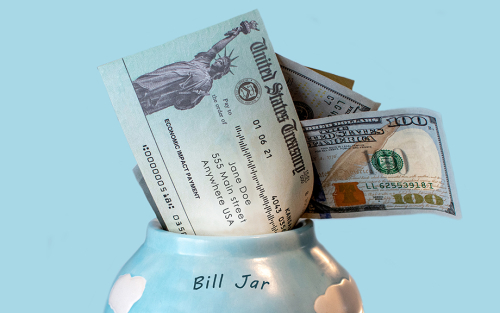Consumers’ Perspectives on the Recent Movements in Inflation
Editors Note: The title of this post has been changed from the original. August 17, 2023, 10:35 a.m.

Inflation in the U.S. has experienced unusually large movements in the last few years, starting with a steep rise between the spring of 2021 and June 2022, followed by a relatively rapid decline over the past twelve months. This marks a stark departure from an extended period of low and stable inflation. Economists and policymakers have expressed differing views about which factors contributed to these large movements (as reported in the media here, here, here, and here), leading to fierce debates in policy circles, academic journals, and the press. We know little, however, about the consumer’s perspective on what caused these sudden movements in inflation. In this post, we explore this question using a special module of the Federal Reserve Bank of New York’s Survey of Consumer Expectations (SCE) in which consumers were asked what they think contributed to the recent movements in inflation. We find that consumers think supply-side issues were the most important factor behind the 2021-22 inflation surge, while they regard Federal Reserve policies as the most important factor behind the recent and expected future decline in inflation.
New SCE Charts Include a Measure of Longer‑Term Inflation Expectations

Today, the New York Fed introduces several new data series and interactive charts depicting findings from its Survey of Consumer Expectations (SCE). The SCE is a representative, internet-based monthly survey of a rotating panel of about 1,300 household heads in the United States. Since January 2014, we have been reporting findings from our monthly survey on U.S. households’ views on inflation, household income and spending growth, their expectations about the housing and labor market, and a range of other expectations about the economy and outcomes for their own household. In addition to publishing interactive charts showing national trends as well as trends by demographic groups (such as age, income, education, numeracy, and geography), we also post the underlying microdata online (with a nine-month lag) to make it available for research purposes. We are adding three new data series to our interactive charts today. The first two concern expectations about future inflation, and the third concerns expectations of future home price growth.
What Do Consumers Think Will Happen to Inflation?

This post provides an update on two earlier blog posts (here and here) in which we discuss how consumers’ views about future inflation have evolved in a continually changing economic environment. Using data from the New York Fed’s Survey of Consumer Expectations (SCE), we show that while short-term inflation expectations have continued to trend upward, medium-term inflation expectations appear to have reached a plateau over the past few months, and longer-term inflation expectations have remained remarkably stable. Not surprisingly given recent movements in consumer prices, we find that most respondents agree that inflation will remain high over the next year. In contrast, and somewhat surprisingly, there is a divergence in consumers’ medium-term inflation expectations, in the sense that we observe a simultaneous increase in both the share of respondents who expect high inflation and the share of respondents who expect low inflation (and even deflation) three years from now. Finally, we show that individual consumers have become more uncertain about what inflation will be in the near future. However, in contrast to the pre-pandemic period, they tend to express less uncertainty about inflation further in the future.
What Are Consumers’ Inflation Expectations Telling Us Today?

The United States has experienced a considerable rise in inflation over the past year. In this post, we examine how consumers’ inflation expectations have responded to inflation during the pandemic period and to what extent this is different from the behavior of consumers’ expectations before the pandemic. We analyze two aspects of the response of consumers’ expectations to changing conditions. First, we examine by how much consumers revise their inflation expectations in response to inflation surprises. Second, we look at the pass-through of revisions in short-term inflation expectations to revisions in longer-term inflation expectations. We use data from the New York Fed’s Survey of Consumer Expectations (SCE) and from the Michigan Survey of Consumers to measure these responses. We find that over the past two years, consumers’ shorter-horizon expectations have been highly attuned to current inflation news: one-year-ahead inflation expectations are very responsive to inflation surprises, in a pattern similar to what we witnessed before the pandemic. In contrast, three-year-ahead inflation expectations are now far less responsive to inflation surprises than they were before the pandemic, indicating that consumers are taking less signal from the recent movements in inflation about inflation at longer horizons than they did before. We also find that the pass-through from revisions in one-year-ahead expectations to revisions in longer-term expectations has declined during the pandemic relative to the pre-pandemic period. Taken together, these findings show that consumers expect inflation to behave very differently than it did before the pandemic, with a smaller share of short-term movements in inflation expected to persist into the future.
Have Consumers’ Long‑Run Inflation Expectations Become Un‑Anchored?

With the recent surge in inflation since the spring there has been an increase in consumers’ short-run (one-year ahead) and, to a lesser extent, medium-run (three-year ahead) inflation expectations (see Survey of Consumer Expectations). Although this rise in short- and medium-run inflation expectations is relevant for policymakers, it does not provide direct evidence about “un-anchoring” of long-run inflation expectations. Roughly speaking, inflation expectations are considered un-anchored when long-run inflation expectations change significantly in response to developments in inflation or other economic variables, and begin to move away from levels consistent with the central bank’s (implicit or explicit) inflation objective. In that case, actual inflation can become unmoored and risks drifting persistently away from the central bank’s objective. Well-anchored long-run inflation expectations therefore represent an important measure of the success of monetary policy. In this post, we look at the current anchoring of consumers’ long-run inflation expectations using novel data from the Survey of Consumer Expectations (SCE). Our results suggest that in August 2021 consumers’ five-year ahead inflation expectations were as well anchored as they were two years ago, before the start of the pandemic.
An Update on How Households Are Using Stimulus Checks

In October, we reported on how households used their first economic impact payments, which they started to receive in mid-April 2020 as part of the CARES Act, and how they expected to use a second stimulus payment. In this post, we exploit new survey data to examine how households used the second round of stimulus checks, abd we investigate how they plan to use the third round.
How Have Households Used Their Stimulus Payments and How Would They Spend the Next?

In this post, we examine how households used economic impact payments, a large component of the CARES Act signed into law on March 27 that directed stimulus payments to many Americans to help offset the economic fallout from the coronavirus pandemic. An important question in evaluating how much this part of the CARES Act stimulated the economy concerns what share of these payments households used for consumption— what economists call the marginal propensity to consume (MPC). There also is interest in learning the extent to which the payments contributed to the sharp increase in the U.S. personal saving rate during the early months of the pandemic. We find in this analysis that as of the end of June 2020, a relatively small share of stimulus payments, 29 percent, was used for consumption, with 36 percent saved and 35 percent used to pay down debt. Reported expected uses for a potential second stimulus payment suggest an even smaller MPC, with households expecting to use more of the funds to pay down their debts. We find similarly small estimated average consumption out of unemployment insurance (UI) payments, but with somewhat larger shares of these funds used to pay down debt.
The Disproportionate Effects of COVID‑19 on Households with Children

A growing body of evidence (here, here, and here) points to large negative economic and health impacts of the COVID-19 pandemic on low-income, Black, and Hispanic Americans. Beyond the consequences of school cancellations and lost social interactions, there exists considerable concern about the long-lasting effects of economic hardship on children. In this post, we assess the extent of the underlying economic and financial strain faced by households with children living at home, using newly collected data from the monthly Survey of Consumer Expectations (SCE).
Inflation Expectations in Times of COVID‑19

As an important driver of the inflation process, inflation expectations must be monitored closely by policymakers to ensure they remain consistent with long-term monetary policy objectives. In particular, if inflation expectations start drifting away from the central bank’s objective, they could become permanently “un-anchored” in the long run. Because the COVID-19 pandemic is a crisis unlike any other, its impact on short- and medium-term inflation has been challenging to predict. In this post, we summarize the results of our forthcoming paper that makes use of the Survey of Consumer Expectations (SCE) to study how the COVID-19 outbreak has affected the public’s inflation expectations. We find that, so far, households’ inflation expectations have not exhibited a consistent upward or downward trend since the emergence of the COVID-19 pandemic. However, the data reveal unprecedented increases in individual uncertainty—and disagreement across respondents—about future inflation outcomes. Close monitoring of these measures is warranted because elevated levels may signal a risk of inflation expectations becoming unanchored.
How Widespread Is the Impact of the COVID‑19 Outbreak on Consumer Expectations?

In a recent blog post, we showed that consumer expectations worsened sharply through March, as the COVID-19 epidemic spread and affected a growing part of the U.S. population. In this post, we document how much of this deterioration can be directly attributed to the coronavirus outbreak. We then explore how the effect of the outbreak has varied over time and across demographic groups.










 RSS Feed
RSS Feed Follow Liberty Street Economics
Follow Liberty Street Economics